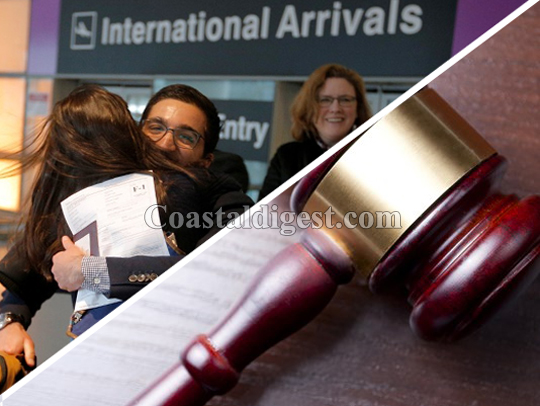San Francisco, Feb 8: President Donald Trump's travel ban faced its toughest test as a panel of appeals court judges hammered away at the government's arguments that the ban was motivated by terrorism fears but also directed pointed questions to an attorney who claimed it unconstitutionally targeted Muslims.
The contentious hearing before three judges on the San Francisco-based 9th Circuit Court of Appeals yesterday focused narrowly on whether a restraining order issued by a lower court should remain in effect while a challenge to the ban proceeds.
But the judges also jumped into the larger constitutional questions surrounding Trump's order, which temporarily suspended the nation's refugee program and immigration from seven mostly Muslim countries that have raised terrorism concerns.
The hearing was conducted by phone an unusual step and broadcast live from the court's website to a record audience. Judge Richard Clifton, a George W Bush nominee, asked an attorney representing Washington state and Minnesota, which are challenging the ban, what evidence he had that the ban was motivated by religion.
"I have trouble understanding why we're supposed to infer religious animus when in fact the vast majority of Muslims would not be affected." Only 15 per cent of the world's Muslims were affected, the judge said, citing his own calculations. He added that the "concern for terrorism from those connected to radical Islamic sects is hard to deny."
Noah Purcell, Washington state's solicitor general, cited public statements by Trump calling for a ban on the entry of Muslims to the US. He said the states did not have to show every Muslim is harmed, only that the ban was motivated by religious discrimination.
Clifton also went after the government's attorney, asking whether he denied statements by Trump and former New York City Mayor Rudolph Giuliani, who said recently that Trump asked him to create a plan for a Muslim ban.
"We're not saying the case shouldn't proceed, but we are saying that it is extraordinary for a court to enjoin the president's national security decision based on some newspaper articles," said August Flentje, who argued the case for the Justice Department.
Under questioning from Clifton, Flentje did not dispute that Trump and Giuliani made the statements. Judge Michelle T Friedland, who was appointed by President Barack Obama, asked whether the government has any evidence connecting the seven nations to terrorism.
Flentje told the judges that the case was moving fast and the government had not yet included evidence to support the ban. Flentje cited a number of Somalis in the U.S. who, he said, had been connected to the al-Shabab terrorist group.






Comments
Judges should hammer on the head of racist TRUMP....
Add new comment